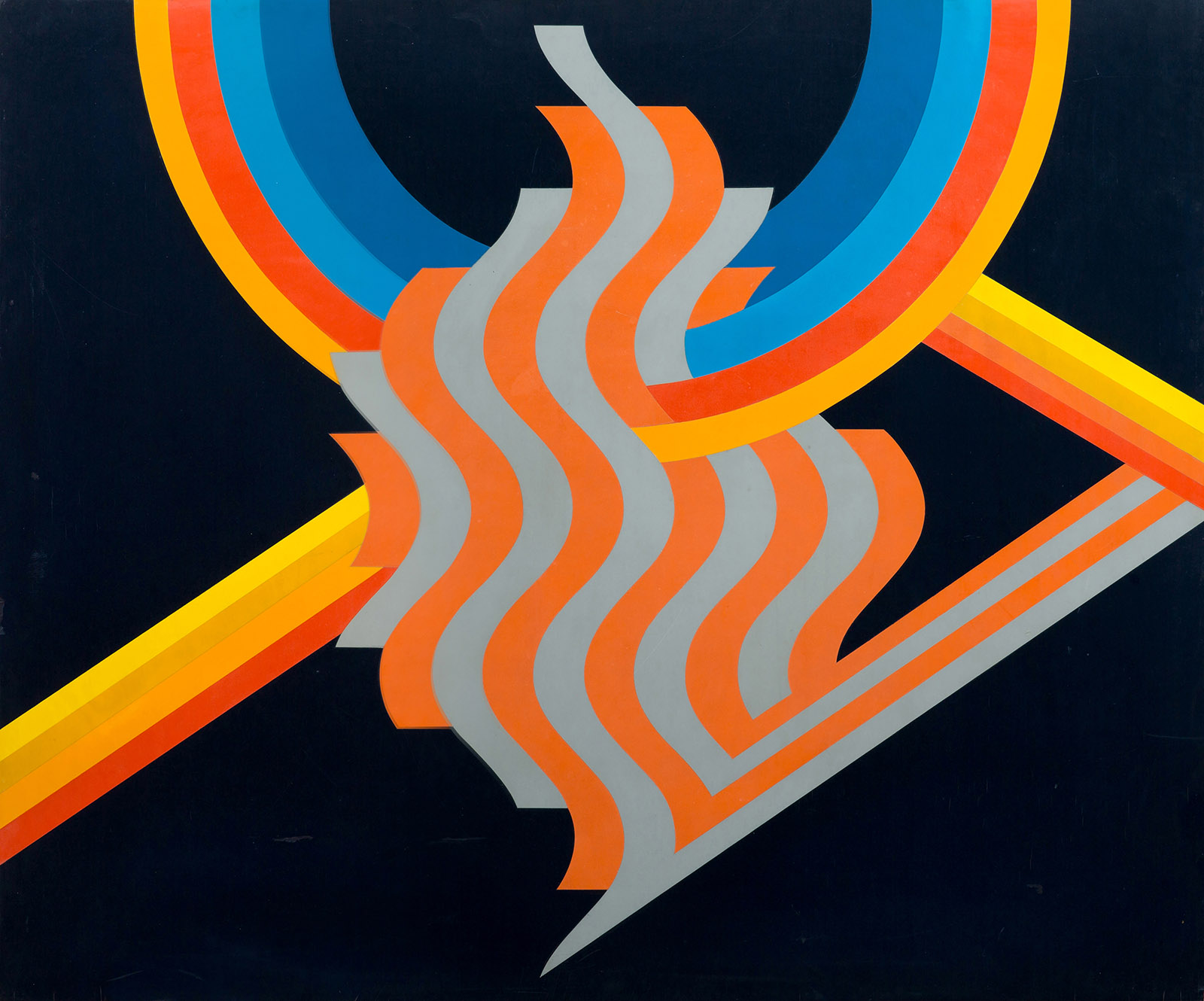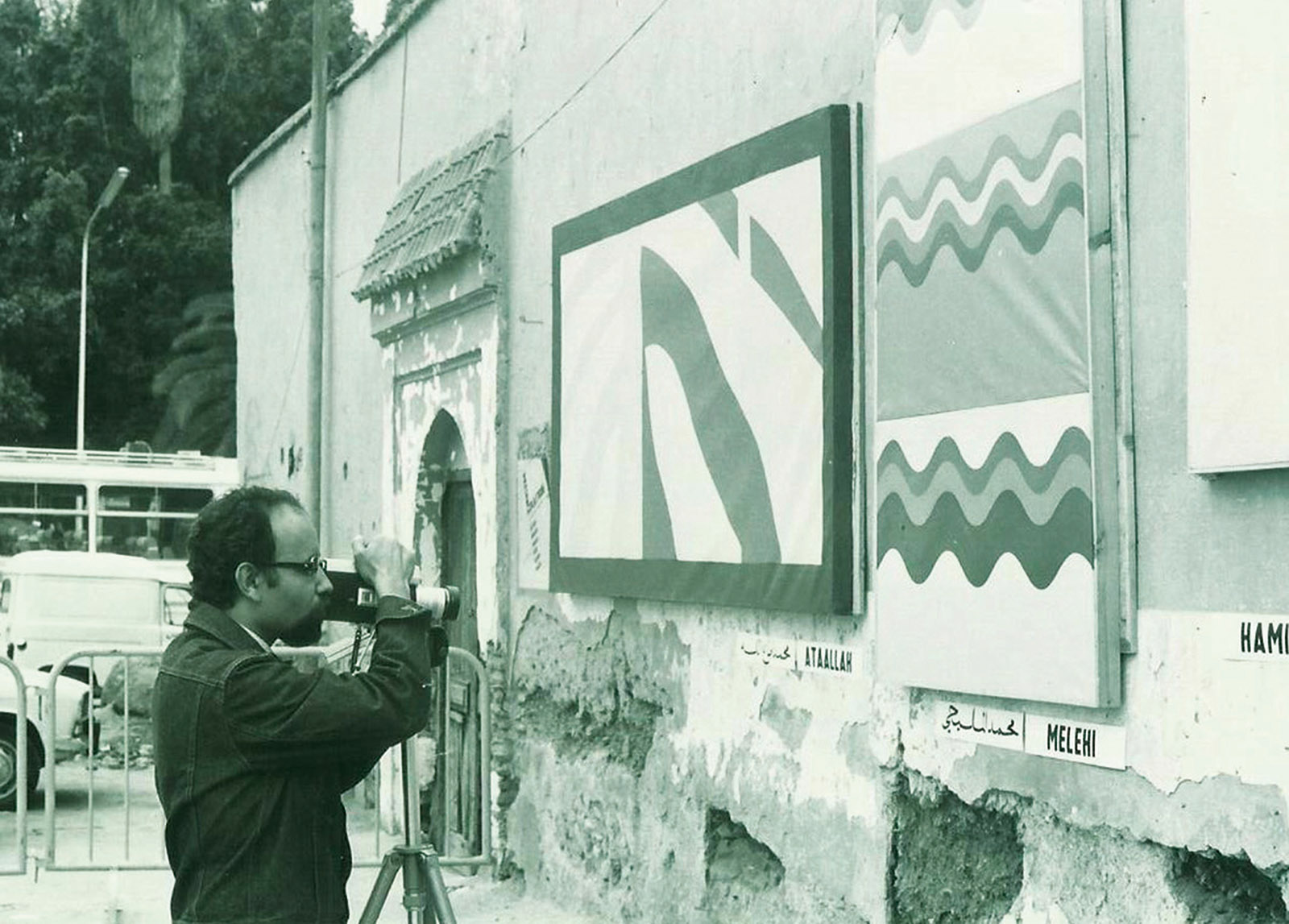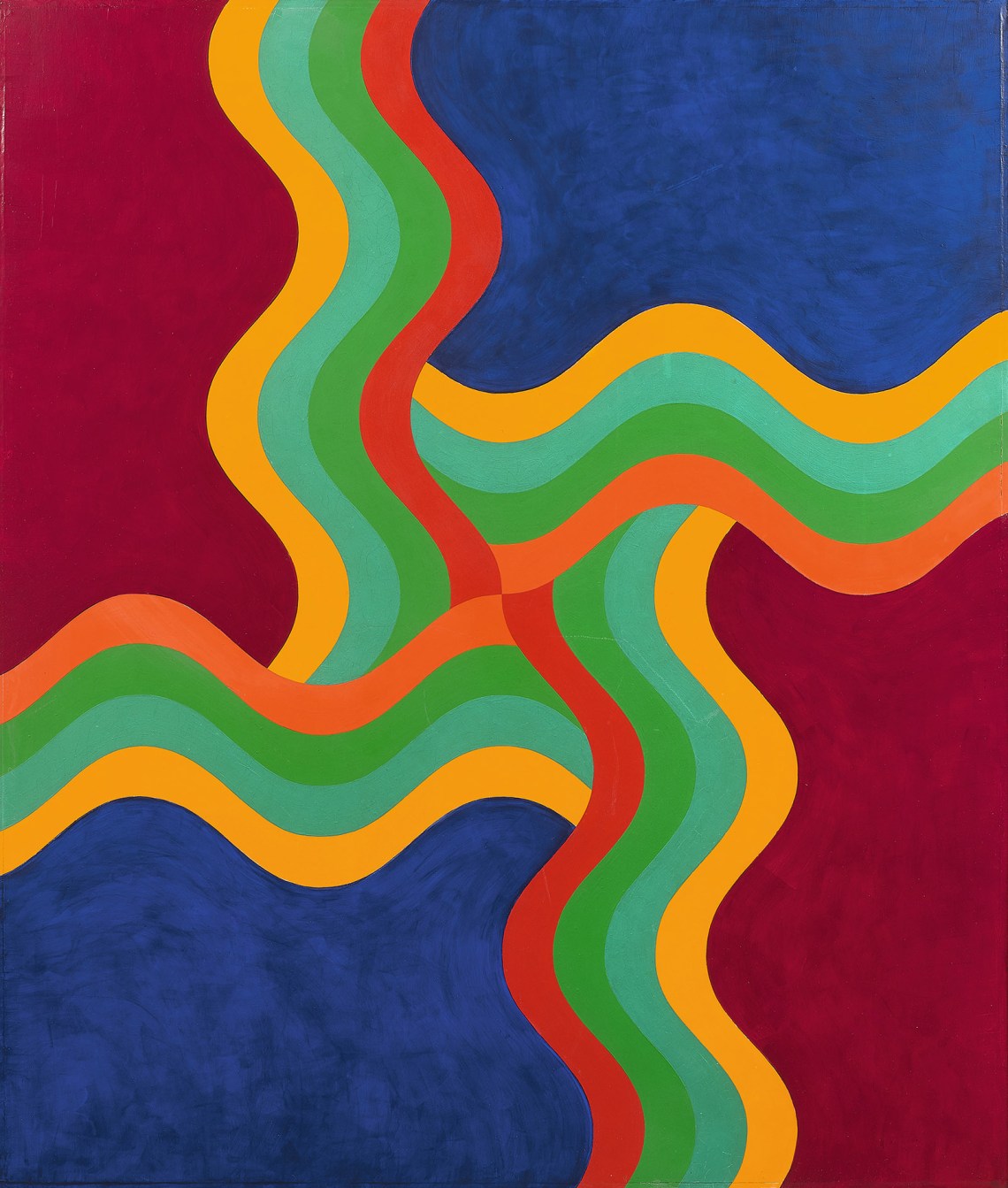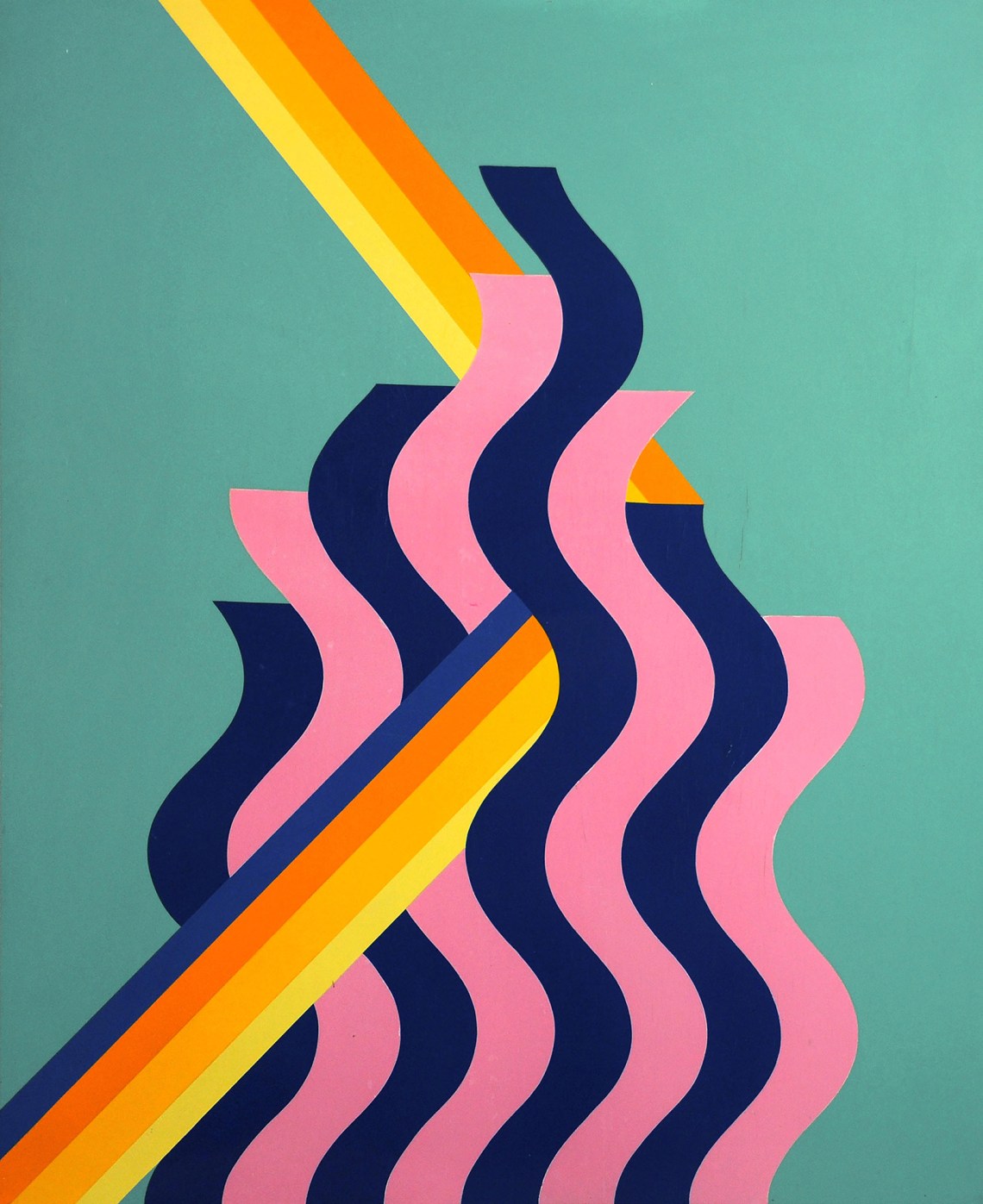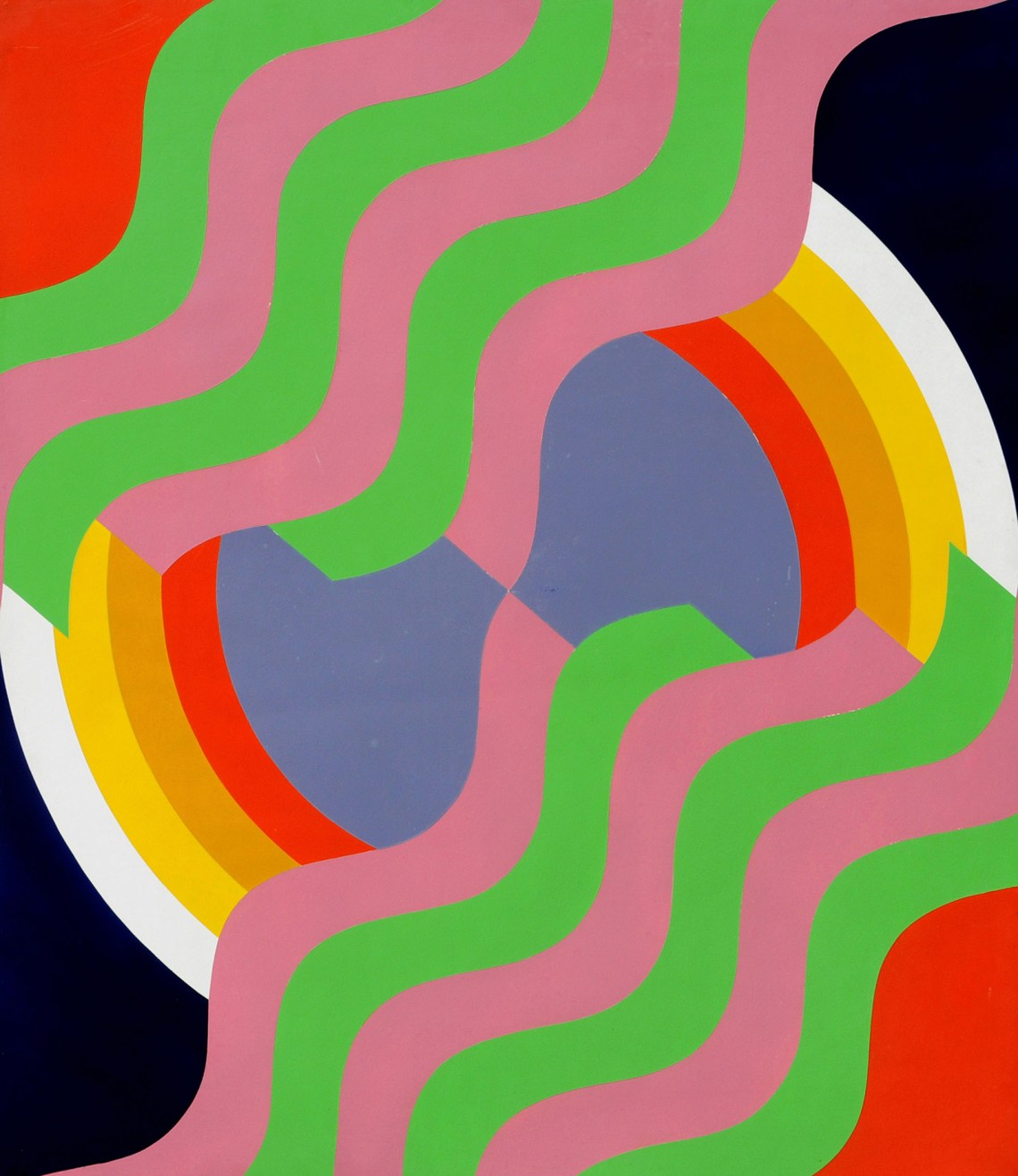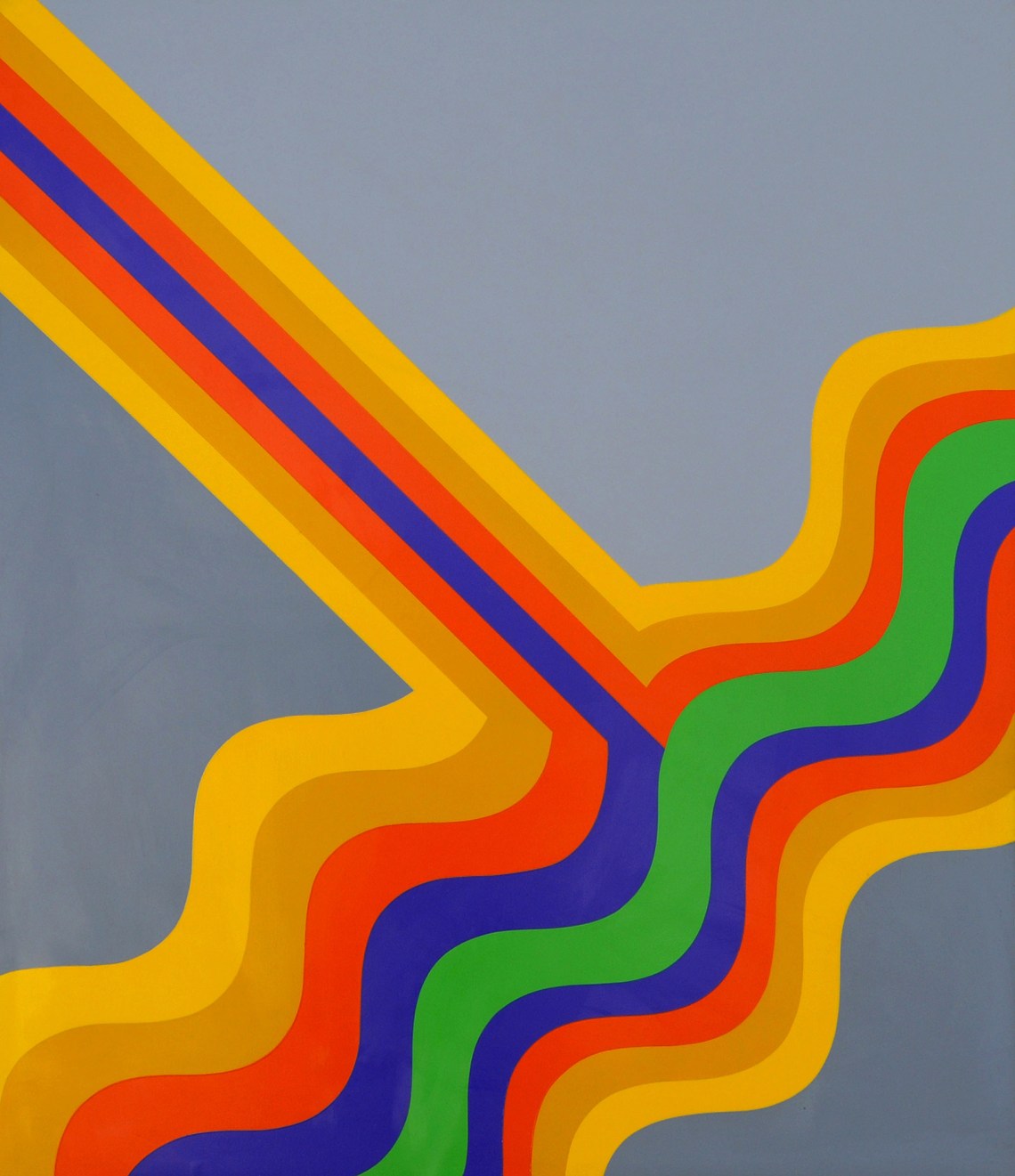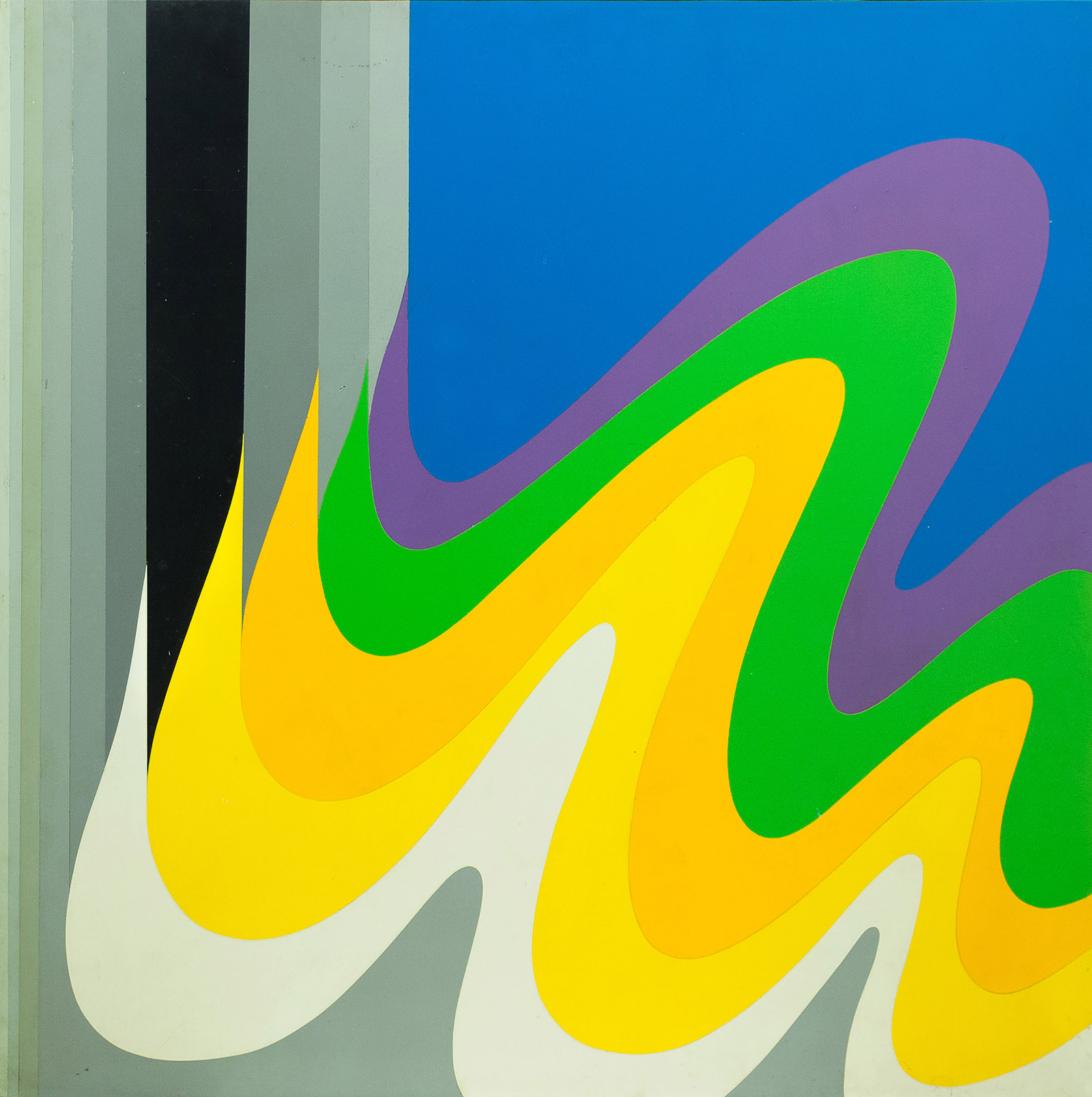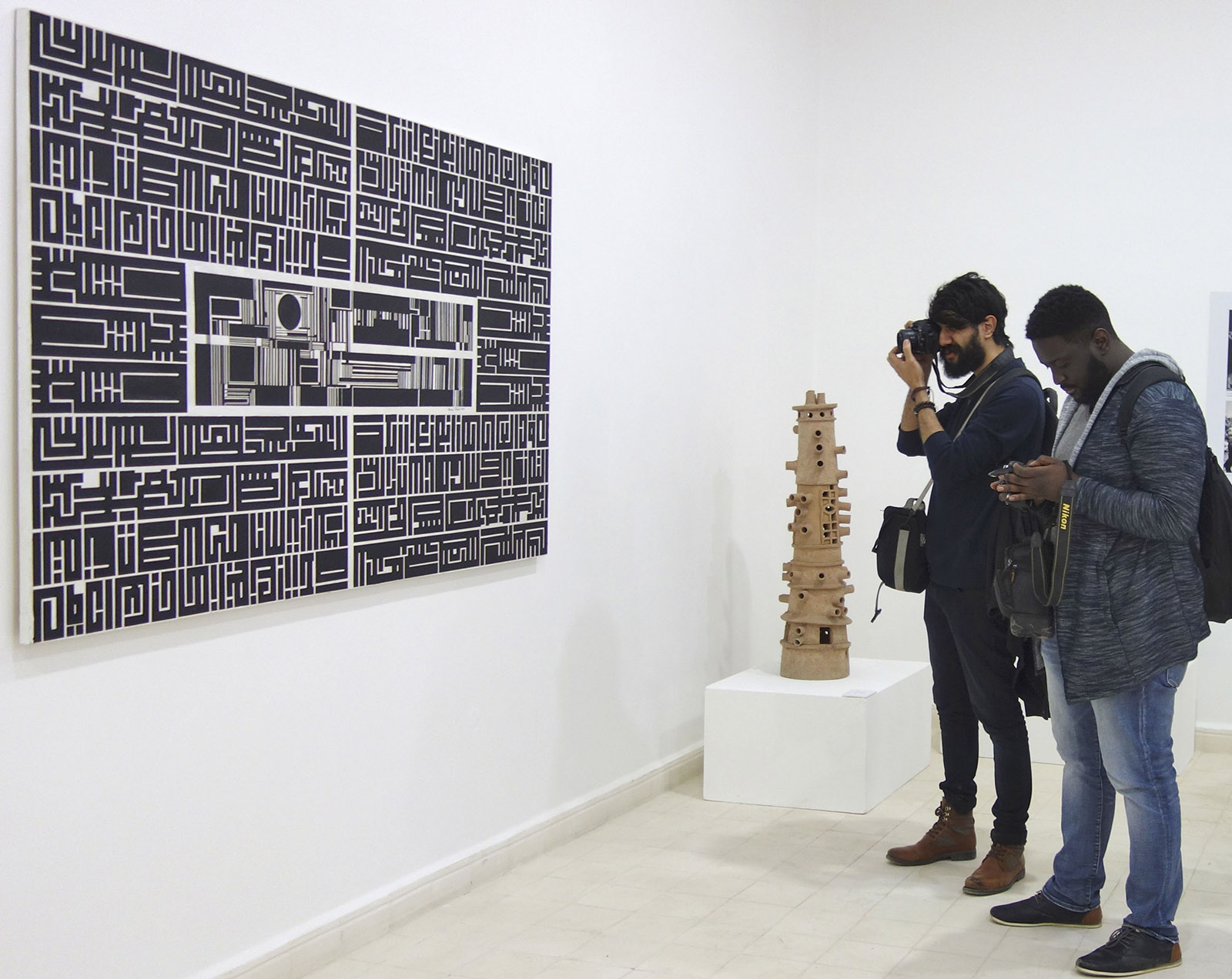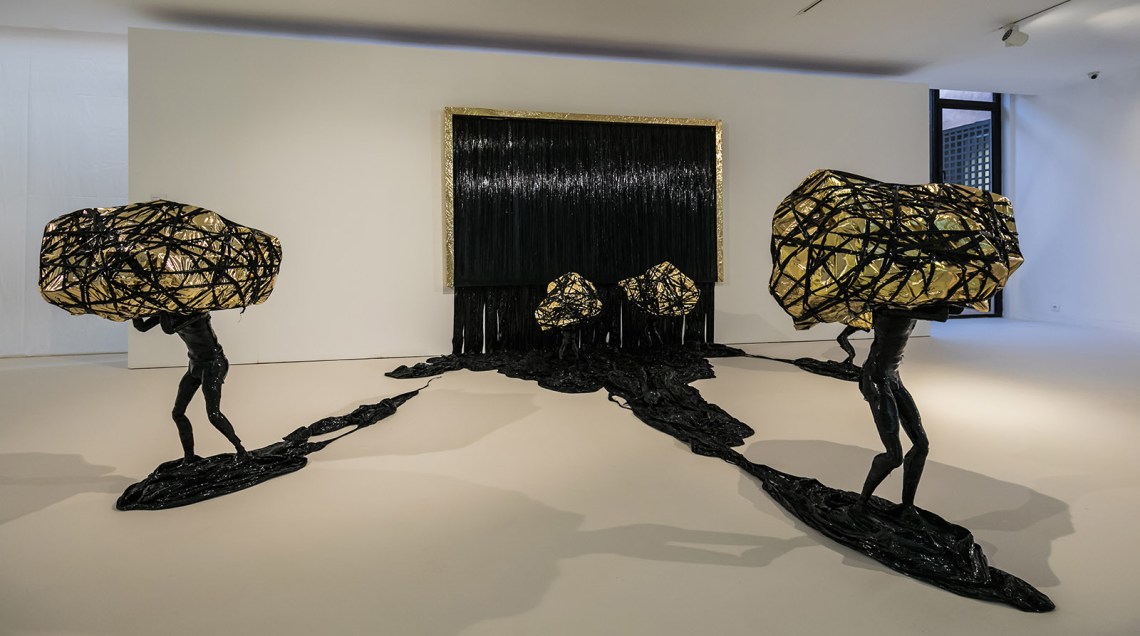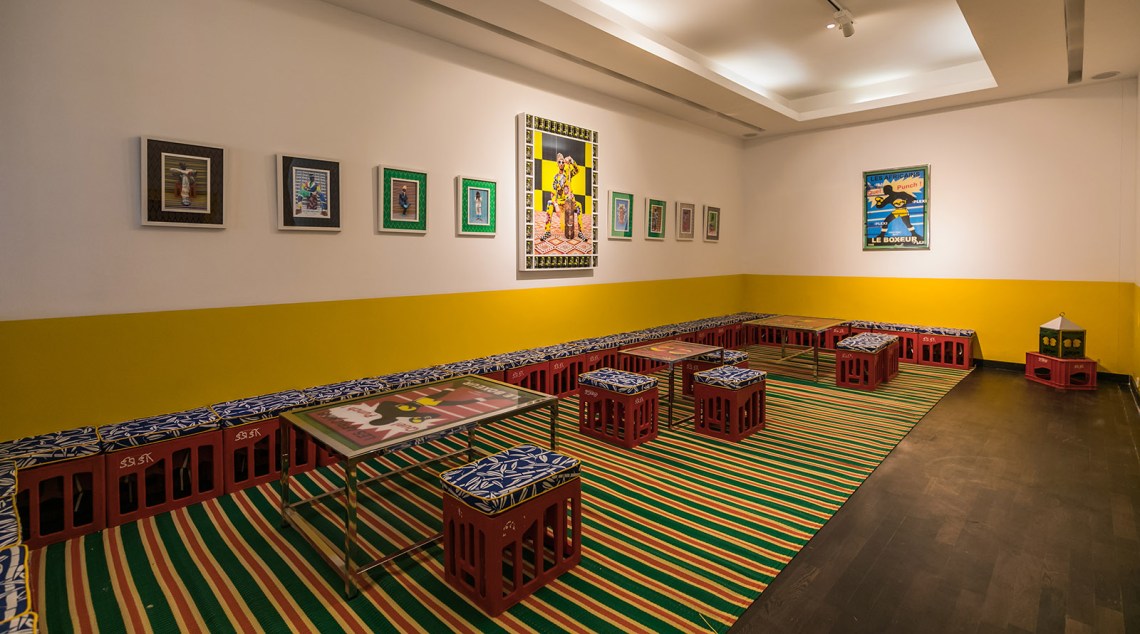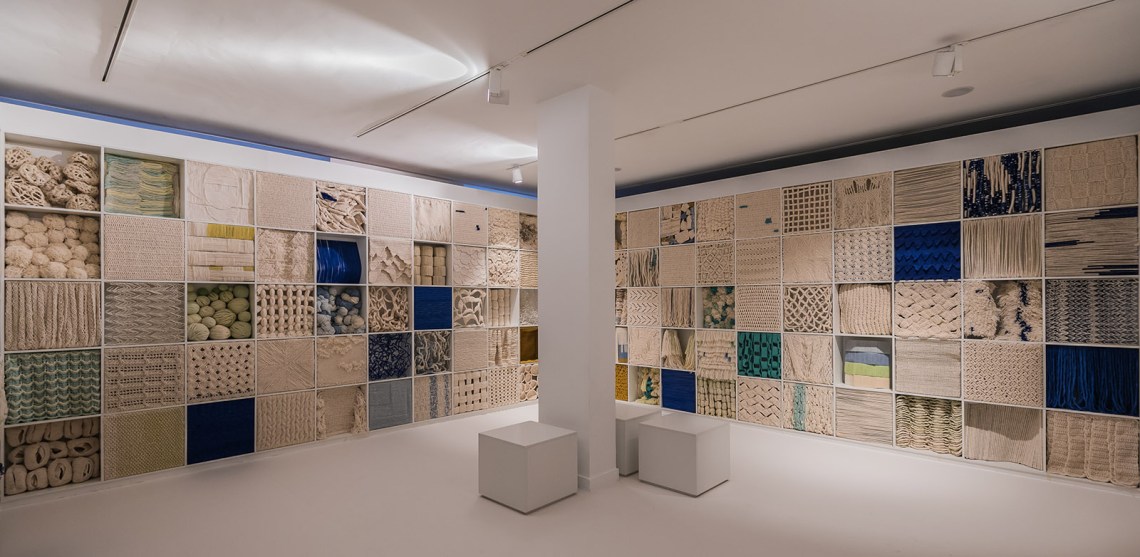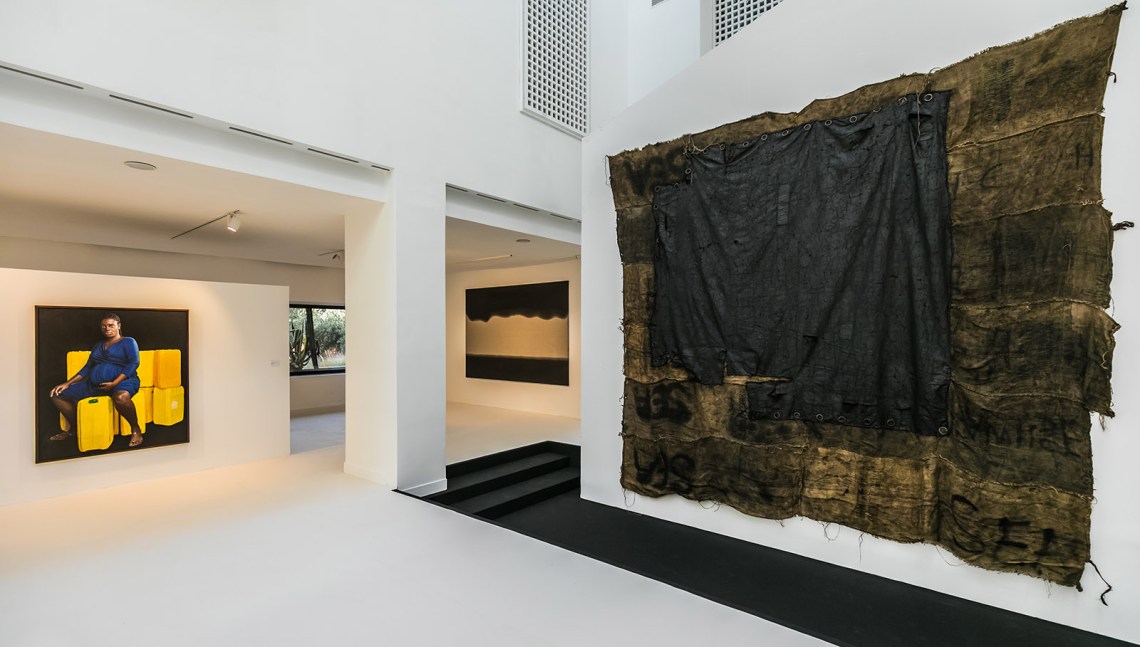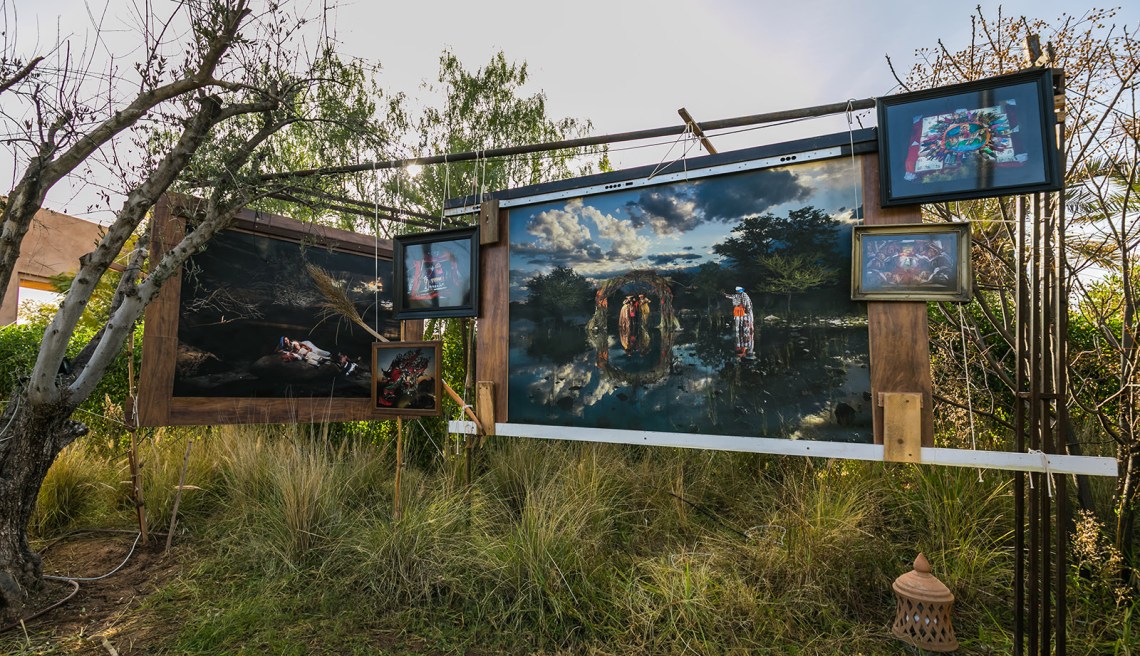Fifty years ago, in the Atlas mountain city of Marrakech, a group of leading Moroccan artists hung their dazzlingly experimental abstract paintings in the Jemaa el-Fna, the great market square in the oasis city at the crossroads of Saharan trade routes. The space, now a hubbub of citrus-juice stalls and snack carts by day, is legendary for its nocturnal storytellers and Gnawa musicians—a tradition protected by UNESCO since 2001 as an intangible piece of world heritage. That self-styled “living exhibition,” which opened on May 9, 1969, amid the dust and winds, lasted ten days and it crystallized the birth of Modern Art in the North African country. The small artists’ group behind it, whose influences ranged from Bauhaus and New York Hard-edge painting to Islamic Sufism and Berber rugs, has now been rediscovered and is gaining recognition as one of the great Modernist moments of the global South. Their market-place show has become a touchstone for contemporary artists and curators across the Arab world and the African continent—where new art museums seek ways to connect with a local public.
In the years following Moroccan independence, in 1956, the artists’ group, though varying in their styles, shared the aim of renewing national culture after colonialism, wresting it from an alienated elite. With “Présence Plastique,” their manifesto exhibition, “we wanted to engage the people… outside the closed circuit of the galleries or the salons—places this audience has never entered,” the six artists said in a joint statement that year (in French and Arabic) in the radical journal of art and politics Souffles. Their aim was to reach the “average person” in the square, “to awaken his curiosity, his critical spirit, to stimulate him so that he integrates new plastic expressions into the rhythm of his life, into his daily space”—expressions that included forms of geometric abstraction that chimed with both a transnational avant-garde movement and the tradition of popular arts within Morocco.
In the Palmery, with its orange groves on the outskirts of the oasis city, the Farid Belkahia Museum opened three years ago—named for one of the leading lights of that manifesto group and occupying his house-cum-studio. The artist, who died in 2014, appears in 1960s photographs in a polo-neck and with a Beatles haircut. In black-and-white archive images of the Jemaa el-Fna, Belkahia and his five fellow artists, all in their twenties or thirties, face the camera in buoyant mood, leaning on railings in front of their defiantly avant-garde works. In other photographs of that period, hawkers with overloaded bicycles and passers-by in djellabas or European dress turn their heads to view the arrestingly patterned paintings arrayed on whitewashed walls.
The experiment in this city with its backdrop of snow-capped peaks continued in a contrasting location—beside the concrete tower blocks of Casablanca on the Atlantic coast, where Belkahia served as the director, from 1962 to 1974, of the École des Beaux Arts, the radical art school to which this group belonged. “Farid Belkahia and the Casablanca School of Fine Arts,” an exhibition tracing his influence through the work of former students, was at his house-museum earlier this year. It followed another show, “The Casablanca School of Art: The Factory of Art and History,” at the 2016 Marrakech Biennial. The school was also a focus of a third exhibition, at last year’s Art Dubai art fair—“That Feverish Leap into the Fierceness of Life,” curated by Sam Bardaouil and Till Fellrath of the curatorial platform Art Reoriented—which explored five significant Arab Modernist schools. (This duo also recently co-curated an influential exhibition on Surrealism in Egypt, “Art et Liberté.”) As this process of re-evaluation gains momentum, Belkahia himself is to have a posthumous solo retrospective next year at the Pompidou Center, in Paris.
Born in Marrakech in 1934, Belkahia came from a family of ethnographic collectors—hence the musical instruments and other artifacts in a studio room preserved within the museum titled “The Artist’s Living Memory.” After studying art and film in Paris and Prague between 1955 and 1962, he returned to take over the Casablanca school. Founded in 1950, during the French Protectorate of 1912–1956, it was still yoked to Paris and in thrall to Orientalist painting. Flinging open its doors to Moroccans, Belkahia and the professors he recruited transformed it into a postcolonial incubator, with what he called a “taste for risk and a continual drive for invention.”
Ever since Eugène Delacroix’s “pilgrimage to the East” in 1832, when the French artist declared, “Rome is no longer in Rome… There are Romans and Greeks at my doorstep,” North Africa had furnished inspiration to European artists, eventually providing an impetus to the Moderns. Henri Matisse adopted an “arabesque” aesthetic. Paul Klee incorporated Arabic script in his abstract paintings. At the Casablanca school, Belkahia introduced the study of calligraphy for the first time and, like many other Modernists, he sought inspiration in a recovered but updated past, declaring, “Tradition is man’s future.”
Advertisement
His own works in the museum begin with early figurative oil paintings and portraits. He made a series of paintings engendered by the Algerian War of Independence (1954–1962), including Tortures (1961–1962), which was acquired by Tate in 2016. Yet he abandoned easel painting on canvas to work in the mid-1960s with locally mined copper, which he hammered, oxidized, and crumpled into abstract bas-reliefs—some resembling fragments of Arabic lettering. Later, he adapted artisanal leather techniques, washing, softening, and stretching hides like parchment, and replacing chemical products with natural pigments such as henna, turmeric, and cobalt. Lambskin works on show in the museum’s permanent exhibition include giant cutouts of hands, imprinted with eyes, triangles, and other Berber-derived symbols, and a stylized Jerusalem in earth tones.
*
Perhaps the most dynamic catalyst of innovation recruited by Belkahia was Mohamed Melehi, who taught at the school in 1964–1969, and, now eighty-two, lives in Marrakech and Tangiers. Melehi’s first UK solo show, “New Waves: Mohamed Melehi and the Casablanca Art School,” was at the Mosaic Rooms in London earlier this year, comprising major works from the 1950s to the 1980s. A companion book, co-edited by Maud Houssais and Fatima-Zahra Lakrissa, is to be published by Zamân Books and the Mosaic Rooms at the end of the year. For the show’s curator, Morad Montazami, Melehi is the “godfather of Moroccan Modernism.” Speaking to me in London in June, Melehi described the shortlived movement of the 1960s as a “golden period.”
Born in 1936 in the seaside town of Asilah, near Tangiers—a city under American cultural influence during World War II—Melehi resolved to become an artist after watching Vincente Minnelli’s 1951 movie An American in Paris. Melehi studied fine arts in Tétouan (then in the Spanish Protectorate in northern Morocco), as well as in Madrid and Seville, before moving to Rome in the late 1950s. He found Italy, then a vanquished power, more culturally open than fascist Spain under General Franco. In Rome, he absorbed Marxist ideas, the films of Fellini and Visconti, and Japanese cinema (Kurosawa’s 1951 film Rashomon reminded him of Sufi mysticism). He also pursued a lifelong love of jazz, and is pictured in a 1962 photograph playing the drums in his Rome studio. For a time, under the influence of Zen philosophy, he eliminated color from his work, painting only in black and white.
As a Rockefeller scholar at Columbia University in New York in the years 1962–1964, he immersed himself in the jazz scene, seeing Miles Davis, Thelonious Monk, and Charles Mingus play. While there, he took part in MoMA’s group show “Hard Edge and Geometric Painting,” in 1963. His somber, austere works made in Italy, such as the paper-on-sacking collage Wounds (1959), gave way to a softer abstraction, and to acrylic paintings such as Sleeping Manhattan (1962), whose bright squares recall both skyscraper windows and perforated data cards. He had seen a Jackson Pollock show in Rome, and found that action painting, Zen philosophy, jazz music, cybernetics, and Sufism came together “like ratatouille,” in pulsating, rhythmic bursts of psychedelic color, in which his signature wave pattern began to appear.
The impact of Bauhaus philosophy on the New York movement, with its view of the artist as an “exalted craftsman,” and its idea that “art exists everywhere,” spurred Melehi (who is, like many Moroccans, of Arab and Berber ancestry) to re-evaluate popular arts in rural Morocco. Like Islamic art generally, these had been dismissed in the colonial period as “decorative” or “folkloric,” with applied arts such as architecture and calligraphy relegated to a status beneath easel painting and sculpture. “What struck me in the Western world,” Melehi told me, “was the colonizers started being interested in something from the ‘East.’ The colonized person always has an inferiority complex; you give less importance to your own culture. I’m Moroccan and Muslim, ‘Eastern,’ so have nothing to do with modernity or emancipation—that’s a cliché of my being. But that people got interested in my culture, and in Sufism, was a revelation.”
Rockefeller scholarships required the scholar to return home, which Melehi did in the 1960s with the first wave of Moroccans who had studied abroad. His advent was a “cold shower” for the Casablanca school, he recalled, where easel painting still held sway. Throwing out the plaster-cast Greco-Roman busts, he replaced these models with Berber carpets. As he told me, “It was ridiculous to teach a young girl or boy how to draw still-life; more interesting to know your own culture through centuries of what they produced.” He had taken a photography course at Columbia, and opened a dark room at the school, handing students free cameras.
Advertisement
He made a “trip into history,” as he wrote in 1967, doing field work with other teachers. These included the Italian art historian Toni Maraini, his then wife—who compared the movement to the Mexican and Soviet artistic revolutions of the 1920s—and the Dutch anthropologist Bert Flint. Belkahia hired the artists who would join him and Melehi in the Marrakech square project: Mohamed Chabâa (1935–2013) and Mohamed Ataallah (1939–2014), who had both studied in Rome; Mohamed Hamidi (b. 1941), who returned from Paris; and Mostafa Hafid (b. 1942), who came back from Poland. They took inspiration from a complex layering of Afro-Mediterranean visual cultures, from ancient Phoenician and Roman mosaics to Amazigh (Berber), Arab, and Islamic patterns and symbols.
“We came back from Europe and discovered a type of artistic production—the traditional ‘crafts’ of woodcarving, plaster, leatherwork, weaving—that carried the sensibility of the people,” Melehi told me. “It was not regarded as art, only utilitarian: people needed carpets, horse saddles. But there’s a genius dimension of artistic imagination in human beings. What was needed was to bring theory, and a new reading.”
Belkahia, Melehi, and Chabâa coalesced as the Casablanca, or “Casa,” Group in 1966, with a joint exhibition at the Mohammed V Theater in Rabat. The works on show were not for sale, Melehi said, “to show young students that art is a message, an idea, not a product to be sold. For the bourgeoisie, art was considered a luxury piece of furniture.” Their African-inflected abstraction rejected the naive realism expected of Moroccan painters. As Chabâa agued then, “our artistic heritage—that of geometric ornament—is more realist and expressive of our historical reality than any image that depicts a scene from everyday life!” Chabâa ridiculed the objection that abstraction was unintelligible in Morocco: “It appears as if the woman who weaves carpets in the remotest tribe of the Atlas Mountains does not understand the carpets she has woven, the designs of which she herself has created.”
“Abstraction is not foreign to Morocco,” Melehi said in London. “It’s the real expression of North Africa. It’s not true that it was Islam that forbade figures; Morocco before Islam did not develop figuration.” His blazing cellulose-on-wood wave patterns, with parallel lines of brilliant colors—crimson, indigo, saffron, and grass green—seem to stylize the sea and mountains, evoking suns, moons, horizons, and rainbows, in paintings that suggest both the sculptural and the calligraphic. Juxtapositions in the London exhibition with Amazigh tapestries and jewelry, loaned from the Berber Museum in the Jardin Majorelle in Marrakech, reveal how directly Berber art fed Melehi’s tendency toward cosmic abstraction, down to the earthy reds, oranges, and khaki of some wave paintings. For him, the wave is a versatile “alphabetic tool.” He told me: “It’s an organic element, a symbol of sensuality and form related to natural movement like water, fire, music. In traditional African art, there’s always a wave. What struck me in America was the Hertz wave.”
In the absence of Modern Art museums in Morocco—the Mohammed VI Museum for Modern and Contemporary Art in Rabat, showing Moroccan and European art, opened only in 2014—the Casablanca Group continued to hang their paintings in public spaces, and advocated “integrated” art, by which they meant art sited in urban spaces, rather than isolated on gallery walls, and applied arts, from ceramics and graphics to architecture. Melehi founded his own graphic design studio, Shoof. His black-sun logo for Souffles, a quarterly founded by the poet Abdellatif Laâbi in 1966, reveals Japanese influence, as do his covers for Intégrale, a pan-Arab journal he co-founded in 1972. Melehi’s protean wave became a wave-flame in a Palestine poster he designed, a Cuban cigar in another, a mural in a Paris suburb, and a thirty-six-foot-high sculpture of Africa awakening, Charamusca Africana, commissioned for the 1968 Mexico Olympics. Melehi and the Casa Group also explored industrial and interior design. Some like-minded architects in Rabat were among the first to embrace the Afro-Berber-inspired Modernist art, collaborating in the creation of stunning murals and frescoes, such as Melehi’s ceiling, painted in 1969, in the Hotel Les Roses du Dadès, in the High Atlas.
The Jemaa el-Fna show was designed to be a riposte to the official Salon de Printemps held in the government municipality hall. The Casablanca Group read its manifesto there and left. “We chose to show art could be in unusual places, not just hotel salons where the public could not go,” Melehi said. “The Jemaa el-Fna was to let the authorities understand that art was for the people, not only for privileged society; that art is not only a precious object, it’s also an idea, a philosophy, a signal for freedom.” Some intellectuals, particularly on the left, opposed the Casa Group, he said, objecting that their work did not “show the misery of the people.” Yet the principle of the joyous outdoor exhibition became enshrined in the Asilah Arts Festival, co-founded by Melehi in 1978 in his hometown, where Moroccan and guest artists—notably including many from the global South—paint murals every year in the Medina.
Melehi went on to adopt spray paint in “industrial, car-paint colors,” which he saw as “very frank colors, in the spirit of the Moroccan palette. No half-tones; the color comes straight from the can.” When he had the first US solo show by a Moroccan artist, at the Bronx Museum of the Arts in 1984–1985, he was videoed saying, “I ally myself with the traditional artisan, in a studio in a popular neighborhood. I work with the radio on and the door open.” He often worked collaboratively, “demystifying the brush stroke.”
The Casablanca Group had fallen into disarray by the early 1970s, its artists differing over political tactics during the “Years of Lead,” King Hassan II’s descent into autocracy in the 1970s and 1980s, when press and political freedoms were severely curtailed and opponents of the regime were violently crushed. Souffles, which had become associated with a revolutionary student movement at a time of sit-ins, strikes, and labor unrest, was banned in 1972, and the journal’s founder, Laâbi, was arrested by the security services and jailed.
Today, Melehi, the group’s surviving core member, sees scant legacy of its idealistic impulse to create a Modern art movement rooted in Morocco yet open to the world, beyond their surviving body of work and a few students who continued their teaching. The curator Montazami has pointed out that not until 2011 did a painting of Melehi’s New York period enter a museum collection, when Pulsation (1964) was acquired by the Pompidou Center in Paris. For Montazami, the group’s moment was a “golden parenthesis.” Yet their ideas and solutions, from renewal of local materials to collaboration with artisans, laid the ground for Morocco’s contemporary art and undoubtedly influenced people’s notions of how and where it should be shown.
*
Just outside Marrakech, a magic circle of gravity-defying boulders stands at the entrance to a sleekly repurposed office building, whose rose-pink brick echoes the color of the city walls. Fatiha Zemmouri’s installation Gravity and Grace is part of “Material Insanity,” a group show of thirty-four artists (twelve of them Moroccan) at the Museum of African Contemporary Art Al Maaden (MACAAL). Completed in 2017, it is described by its president, Othman Lazraq, as the “first museum of African contemporary art in Africa.” (The Zeitz Museum of Contemporary Art Africa (MOCAA) in Cape Town opened later that year.) The private collection of his father, the hotel developer Alami Lazraq, forms the basis of the museum, situated next to a family-owned golf course that is also a sculpture park. Of more than 2,000 pieces, “60 to 70 percent” are African, roughly half of those Moroccan. Since 2010, the collection has embraced sub-Saharan art—a move in accord with the Casablanca Group’s disregard for colonial borders.
For Othman Lazraq, an architect, in a country where “98 percent of Moroccans have never been to a museum, and only 0.3 percent of the national budget is for culture,” the private museum has a mission to make art accessible to a wider public. He quoted me the Prix Goncourt-winning Moroccan writer Tahar Ben Jelloun, who reinforced the Casablanca Group’s stance with a famous rallying cry in Souffles in 1970: “An end to the myth of art meant only for initiated intellectuals… The artist needs to learn the language of the masses.”
“In Morocco, we have art but it’s foreigner-led and for an international audience,” Meriem Berrada, the museum’s artistic director, told me. “Tourists are the first audience—but that’s changing.” Estimated visitor numbers have grown from just 500 a year at the beginning to as many as 10,000, a fifth of them school children. On monthly “Couscous Fridays,” invited groups such as women’s associations, gardeners, and taxi-drivers eat in the grounds before getting a guided tour of the museum. “Material Insanity” presents art works in a prodigious range of materials, often associated with trade and waste. Its everyday matter, the museum’s exhibitions director, Janine Gaëlle Dieudji, said, provides a “way to engage our public: a kid from the Medina can recognize and reconnect with familiar objects from daily life.”
Pushing local materials beyond the familiar to postmodern effect, Mehdi-Georges Lahlou’s exquisite, pale-yellow sculpture, Head (2013), balanced upside-down as though freshly severed, creates a tension between the cozy domesticity of the cooked couscous, adhered with epoxy resin, and the brutal act of decapitation it suggests. For the sculptor, born in France to a Moroccan father and Spanish mother, the dissonance alludes partly to the global spread of an exotic food in ignorance of the culture that produced it. As wrenching in its juxtapositions is Frances Goodman’s wall sculpture Roiling Red (2018), in which nauseating reddish-purplish swirls, suggestive of flayed flesh, are composed of acrylic false nails in trending shades—darkly hinting at the beauty myths behind cosmetic surgery.
In place of the Casablanca Group’s copper, leather, and car paint, the materials to hand fifty years on are more often mass-produced plastics and industrial detritus. In Alexandra Karakashian’s fascinating installation Black Sea (2019), a tray of used engine oil creates an inexorably seeping stain upon a canvas suspended above. Clay Apenouvon’s powerful installation Film Noir, Survival Frame, Smugglers (2019) uses black-plastic stretch-film wrapped around found objects (a boot, a flashlight) to suggest our status as voyeurs in the media “packaging” of the unfolding Mediterranean disaster of desperate migrants risking their lives at sea. The Togolese artist’s frail figures, bearing outsize burdens like Atlas, emerge in 3-D from a seeming giant TV screen. In Olumide Onadipe’s bas-relief Crowd Commotion (2017), a blue-tinged oceanic encrustation conjures both the politics of water and marine pollution through its hundreds of scrunched-up polythene water bags.
For contemporary artists, trash heaps are an emblematic source of the local. Moffat Takadiwa’s Washen Again (2019) is a red-and-green drape made from toothbrushes and dish-liquid caps, the Zimbabwean artist salvaging both out of necessity and to reflect the deprivation of others. Pharmaceutical waste is astonishingly repurposed in an untitled work of 2017 by the Moroccan artist Adil Karkoui. In the enlarged photograph, rows of anguished masks are minutely wrought on used pill blister-packs. Cyrus Kabiru’s series C-Stunners (2017) refashioning obsolete electronic waste into Afrofuturist eyewear, is displayed in cases alongside photographs of the Kenyan artist wearing his sculptures—a knowing bid to brand and authenticate his work.
In Casablanca Group style, both local pigments and artisanal collaboration are central to the practice of Yasmina Alaoui, a US-born artist of French and Moroccan parentage, now based in Marrakech. Finger Casts (2019), a bas-relief using pharmaceutical plaster bandages to cast the fingers of local craftswomen, reflects the hardship of their repetitive labor while evoking, in miniature, the white-robed crowds in Mecca. Elsewhere, she embraces the artisanal dyes Belkahia elevated: henna, kohl, indigo. “Tuareg indigo blue has been a symbolic color locally for centuries,” she told me, “even if it’s called ‘Yves Klein blue’ or ‘Yves Saint-Laurent blue.’”
The spirit of the Marrakech market manifesto seemed most palpable in two immersive installations. Amina Agueznay’s Noise (2018) is a cocoon-like sanctuary in white, yellow and “Majorelle-blue” hand-dyed wool, the colors of Asilah’s Medina walls. Comprising hundreds of cube-shaped niches (based on a rug-weaver’s unit of measurement) filled or covered with knitting, crochet, macramé, weaving, braiding, and pompons, the work evokes sea, fishing nets, sand, and waves, with a soundtrack of the twelve craftswomen’s voices speaking Arabic and recorded in the workshop where the woollen pieces were made. Placing artistic value on artisanship means raising the status of women’s work: all are credited. Agueznay, who returned from the US to work with master jewelers and craftspeople in paper, wood, stone, and basketry, described the installation as a “membrane carrying the women’s emotions,” and a path from functionality to freer self-expression, in which she was merely “the conductor.”
Noise was commissioned for last year’s fortieth anniversary of the Asilah festival that Melehi co-founded. Belkahia was an avowed inspiration for Agueznay, as was her Marrakech-born mother, Malika, who filled two of the niches. Known as Morocco’s first woman Modernist, whose paintings and etchings of biomorphic shapes resemble calligraphic algae, Malika Agueznay was included in the Casablanca School exhibition earlier this year at the Farid Belkahia Museum. She was Melehi’s student at the school from 1966 to 1969.
In a contrasting, yet strangely complementary, room, Hassan Hajjaj’s Le Salon (2019) is furnished with striped rugs and patterned benches for visitors to use, made from red-plastic Coca-Cola crates. The artist’s signature photographic portraits, as in his My Rockstars series, combine pop art, a vibrant Moroccan palette, London fashion photography (his subjects pose in the riotously patterned clothes he’s designed for them), and the sparer, black-and-white West African studio portraiture of Seydou Keita or Malick Sidibé. Hajjaj, who was born in northern Morocco and moved to London aged thirteen, told me the 3-D frames of familiar branded sardine tins or ketchup bottles were partly to create a bridge between the viewer and the bearded men and veiled women whom he elevates to heroic status—as in his Kesh Angels series of Marrakech women on motorbikes. (Some of Hajjaj’s portraits are currently on show in “Get Up, Stand Up Now: Generations of Black Creative Pioneers,”an exhibition at Somerset House in London through September 15.) He also recycles street signage and branded products into wittily allusive merchandise, inspired by the Marrakech marketplace as much as by the migrant worlds of London and Paris. “I love working here with the artisans—learning crafts,” he has said.
Reversing the trajectory of the original Jemaa el-Fna show, Hajjaj’s installation brings the Medina to the museum, lowering the barriers between art and audience. It recalls the Casablanca Group, not in style but in the bold spirit with which it combines a vernacular Moroccan visual idiom, from the streets and souks, with eclectic global influences, while escaping the clichés of exoticism imposed by others.
“One cannot import Modernism,” Melehi wrote in Souffles, back in 1967, adding that, for him, “Modernism is situated precisely in… the rehabilitation of our own values.” The Casablanca Group’s brilliant steps towards self-recovery and renewal, the cultural decolonization its artists strove to complete in the early years of independence, opened a path that continues to be liberating.
“Material Insanity” is at the Museum of African Contemporary Art Al Maaden (MACAAL), Marrakech, Morocco, through August 15. “New Waves: Mohamed Melehi and the Casablanca Art School” was at the Mosaic Rooms, London, from April 12 through June 22, and opens at MACAAL in Marrakech on September 20. The Farid Belkahia Museum is at Dar Tounsi, Palmeraie Nord, Marrakech.

